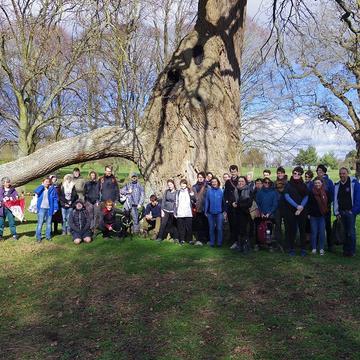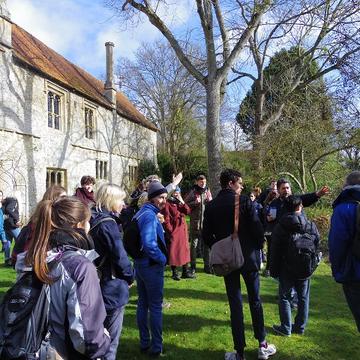Elliot Vale will be exploring the translation of Genesis B in more detail at the first OCCT discussion group of Hilary Term: Monday 22nd February, 12.45–14.00, Seminar Room 10, St Anne’s College. Lunch provided.
The Old English poem Genesis B is unique as the only verifiable example of a vernacular-to-vernacular translation during the Anglo-Saxon period. Interestingly, its source language Old Saxon and target language Old English were closely related and mutually intelligible. John Hines argues that the residual ‘Old Saxon’ nature of the Old English poem ‘displays the cultural connexions of a now Saxon-dominated England with the Christian Continent’. In this, Genesis B epitomizes the Anglo-Saxons’ continued and evolving relationship with the continental Saxons, exhibiting both the Saxon ‘other’ and the Saxon ‘self’.
In this blogpost, I will survey the historical and linguistic interrelation of the Anglo-Saxons and the Old Saxons to understand what might have motivated the translation of Genesis B.
Let’s begin before the beginning with the pre-migration linguistic situation of Germanic Europe. The Germanic dialects spoken in north and north-west Europe around the 5th century are known as the ‘West Germanic’ languages. They consisted of three main groups, the ‘Irminonic’ (which became modern High German), ‘Istvaeonic’ (which became modern Dutch), and ‘Ingvaenoic’ (which became modern Frisian, Low German, and English). This last group, also known as ‘North Sea Germanic’, divides further into Anglo-Frisian (a branch including both Old English and Old Frisian) and Low German (which includes Old Saxon). During the Age of Migration from the 4th to the 6th century, peoples whose languages were closely related and mutually intelligible migrated in groups and merged. This seems to have happened with the Germanic tribes who migrated to Britain in the 5th century.

This migration made a distinction as well as highlighted a commonality between what would become the Anglo-Saxons in Britain and the Old Saxons on the continent. In his Ecclesiastical History of the English People, the Northumbrian scholar Bede names three Germanic tribes who migrated to Britain in the fifth century: the Angles, Saxons, and Jutes. He has this to say about them:
‘The people of Kent and the inhabitants of the Isle of Wight are of Jutish origin […] From the Saxon country, that is, the district now known as Old Saxony, came the East Saxons, the South Saxons, and the West Saxons. Besides this, from the country of the Angles, […] which is called Angulus, came the East Angles, the Middle Angles, the Mercians, and all the Northumbrian race […] Angulus is said to have remained deserted from that day to this.’ (Bede 51)
The peninsular Jutes seem have been absorbed by Danish expansion westward into the apparently deserted homeland of the Angles (thought to be Angeln in Schleswig Holstein). Only the Saxons became distinguishable as two peoples, the insular Anglo-Saxons in the southern English Kingdoms of Wessex, Essex, and Sussex and the continental Old Saxons in Old Saxony. Consequently, the Germanic inhabitants of Britain could maintain a connection with the continent they had migrated from, defining themselves both in relation to and in opposition to it.

After their own Christianisation, the Anglo-Saxons pursued missionary activity on the continent among related Germanic tribes, primarily the Frisians and the Saxons. Missionary work was conducted among these groups because they spoke languages (namely Old Frisian and Old Saxon) that were closely related to and mutually intelligible with Old English. In the early 8th century, St. Boniface, a Northumbrian monk, established an important abbey for the Saxons at Fulda in Germany. In a letter, Boniface implored the Anglo-Saxon bishops in England to ‘Take pity upon them [the Saxons]; for they themselves are saying: “We are of one blood and one bone with you”’ (75). Clearly, it was recognized that the insular and continental Saxons were connected historically, linguistically, as well as ethnically.
With Christianity came literacy, and the Saxons seemed to define their nascent literary culture in the light of the Anglo-Saxons who converted them. This is exemplified in a pair of Latin texts, the Praefatio and Versus, which are thought to have once prefaced an edition of Heliand, an Old Saxon gospel poem. Among other points touching on Saxon poetry, these texts describe a Saxon shepherd who was divinely inspired to compose vernacular biblical poetry. This is clearly modelled on the Cædmon legend as narrated in Bede’s Ecclesiastical History, a text Anglo-Saxon missionaries took with them to the continent. In Bede’s account, a lay brother at Whitby Abbey abandons a feast in shame at his inability to perform a secular song. Nevertheless, he is visited by an angel and divinely inspired to create religious alliterative poetry, thereby fusing the traditional Germanic verse form with Christian subject matter. A Saxon scribe seems to have borrowed this legend to provide a similar ‘origin story’ for Saxon religious alliterative poetry.
Cultural influence seems to have been mutual, however. For example, Barbara Raw has shown how the illustrations in the Junius 11 manuscript cohere more with Genesis B than Genesis A. From this observation, she argues that the illustrations must derive from an illustrated edition of the complete Old Saxon Genesis. This now lost manuscript was likely given as a wedding gift to King Æthelwulf (Alfred’s father), who married the daughter of the Frankish Emperor Charles the Bald in 856. Furthermore, King Alfred’s educational reforms drew many scholars from the continent, such as a man known as ‘John the Old Saxon’. Alfred’s biographer Asser describes him as ‘a man of most acute intelligence, immensely learned in all fields of literary endeavour’ (93). Alfred’s prioritization of the translation of Latin texts into English also strongly suggests that Genesis B was translated at his court. Thus, Anglo-Saxons helped to establish a Saxon literary culture that consequently influenced the further development of their own.
An important text Alfred commissioned to be translated was the fifth-century Latin History Against the Pagans by the Spanish theologian Paulus Orosius. The Old English version of this work contains an interpolated pair of texts, editorially named ‘Ohthere and Wulfstan’. These texts detail anecdotally the passage of two seafarers all around Scandinavia and the Baltics. An editorial aside as Wulfstan approaches his native Hedeby on Jutland remarks that ‘[t]he English lived in that region before they came to this country’ (Orosius 43–5). So we have come full-circle: the Anglo-Saxons’ continued sense of themselves as a migrant nation only strengthened their ties to their ancestral homelands on the continent.
The Anglo-Saxons never forgot their origins on the continent nor played down their continued relations with it but used it in the formation of their own identity. Genesis B is an Old English poem in language and style but retains enough Old Saxon features to nevertheless convey a deliberate ‘feeling of foreignness’. Lawrence Venuti argues that ‘translation wields enormous power in the construction of national identities for foreign cultures’ (‘Regimes’ 209). As a translation, Genesis B constructs a foreign identity for a national culture, containing in its hybrid language and literary style the Saxon ‘other’ and the Saxon ‘self’.
Elliot Vale holds a BA in English from the University of York and an MSt in English 650–1550 from the University of Oxford. His research interests lie in applying modern translation theory to medieval texts and the reception of Old English poetry from the 19th to the 21st century, especially through translation. He has written on translational ‘bias’ in the Old English poem Exodus and the Old English Hexateuch and on the stylistic analysis of metrically imitative translations of Beowulf. He translates from Old English and Swedish.
Title image: Oxford, Bodleian Library, MS. Junius 11, p. 31.
Works cited
Asser. Alfred the Great: Asser’s Life of King Alfred and Other Contemporary Sources, edited and translated by Michael Lapidge and Simon Keynes, Penguin Books, 1983.
Bede. Bede’s Ecclesiastical History of the English People, edited and translated by Betram Colgrave and R. A. B. Mynors, Oxford University Press, 1969.
Boniface. The Letters of Saint Boniface, translated by Ephraim Emerton, Norton, 1976.
Hines, John. ‘Attitude Problems? The Old Saxon and Old English Genesis Poems’. Language Structure and Variation: A Festschrift for Gunnel Melchers, edited by Magnus Ljung, Stockholm Studies in English 92, 2000, pp. 69–90.
Magoun, Francis P., Jr. ‘The Praefatio and Versus Associated with some Old Saxon Biblical Poems’. Medieval Studies in Honor of Jeremiah Denis Matthias Ford, edited by Urban T. Holmes, Jr. and Alex J. Denomy, Harvard University Press, 1948, pp. 107–136.
Orosius, Paulus. The Old English History of the World: An Anglo-Saxon Rewriting of Orosius, translated and edited by Malcolm Godden, Harvard University Press, 2016.
Raw, Barbara. ‘The Probable Derivation of Most of the Illustrations in Junius II from an Illustrated Old Saxon Genesis’. Anglo-Saxon England, vol. 5, 1976, pp. 133–148.
Venuti, Lawrence. ‘Translation as cultural politics: Regimes of domestication in English’. Textual Practice, vol. 7, no. 2, 1993, pp. 208–223.





















